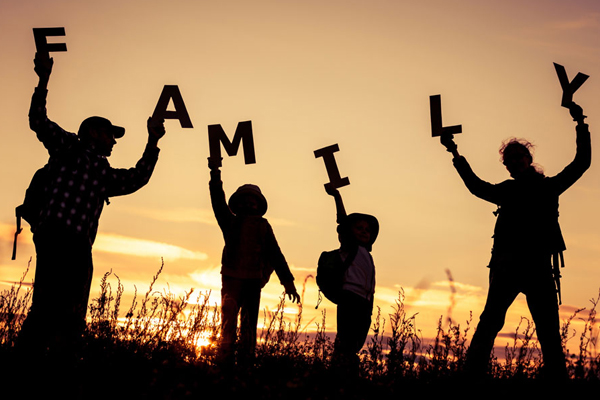Off my chest
Whose journey is this? Who is the traveler and who are the attendants on their journey? We have a responsibility not only to these hurting children and their families but also to the systems and institutions that contributed to their marginalization and dysfunction because that is a real factor in most situations. When it comes right down to it, the child needs to know that their family cares enough to do better and that society cares enough to try to make that happen for them. Since our society depends on the functioning family it should try harder to help it stay together. We should be very clear that foster care is, at its core, an interim measure while the family stabilizes and dedicate our resources to maintaining and respecting the bonds that were forged in earlier, happier days. We should demand enough contact between parent and child during a foster care placement that the child never doubts that home is not far away and, whenever possible, that the foster parents and the biological parents are a team working together for the child in care. We must do a better job of fostering empathy for the parents. We must assure that professionals: teachers, physicians and behavioral health workers are all literate in the consequences of trauma and how these concepts can really help the child and any caregiver interested in helping the child. DCS workers must be closely supervised to operate within the boundaries of their proscribed role and to respect the foster and biological family even in the midst of the chaos. Today, I would be remiss if I didn’t mention that the police and all other parties to these family tragedies must rise above racial hatreds and abuse of power and comport themselves admirably rather than appallingly. It’s going to take a well-coordinated effort to make this reality. The kids need us to accept this challenge. I hope we are all up for it. Thanks, I feel better just getting this on paper.
The Players
I was able to offer real resources to someone in need last week. That caller was frustrated that after a string of professionals had thrown up their hands in confusion, DCS couldn’t offer her any ideas for next steps. It occurred to me that she really didn’t know to whom to turn in her moment of desperation. There are so many players, so many disconnects here that it is hard to know where to start but I’m gonna try. Maybe you’ve had similar frustrations. Everyone is this circle of care has a role to play in the “rescue” of a child from a family in dire need of help. Here is my take on who does what in this circle of care, where our priorities should be and where things break down:
- As a nation, we have decided that the biological nuclear family is worthy of respect and protection as the basic unit of society, responsible to socialize the next generation. But Tolstoy nailed it: “Happy families are all alike; every unhappy family is unhappy in its own way.”
- Parents give birth then may lose their way in this role of socialization in one way or another. Poverty and under employment may stress families beyond their ability to cope. The pervasive availability of drugs in our culture offers escape from whatever pain or disappointment continues to burden the now-fertile adult. The violence that typically accompanies access to drugs is part of the deal and is another source of potential trauma for both parent and child. Too many seem to not have the slightest clue what it takes to raise a healthy child. They don’t know because their parents didn’t know, either. Even worse, various types of abuse and the resulting trauma response patterns often become normalized across generations. The media depicts “welfare queens” and “dead beat dads”. Society’s ability to show empathy and respect for struggling families is easily eroded with these labels.
- DCS is called in to determine if the child is in imminent danger and DCS workers collect information about the nature of that “lost way”. They are trained in the legal language of child neglect and endangerment. This is the world they know. They know walking into filthy homes; homes with no food in the house; homes where children are inconveniences; homes where people are too ill or addicted to be the parents the children need; homes where children are resources to be exploited. It is very hard to maintain respect for the sanctity of the family when one sees this day after day. Now the DCS worker may be traumatized, too, suffer burnout or compassion fatigue. They are not usually foster parents nor behavioral health professionals.
- Family Court Judges consider the collected information before deciding if the child must be removed from the home. The Family Court Judge knows the laws that direct the drastic step of removing a child from its parents. He has to hear from the Guardian ad Litem, the CASA, the DCS worker, the parents’ lawyer and any provider involved with the parents or the child. Sometimes, the most articulate person gets his attention most easily. That’s not usually the parents. The judge is not usually a foster parent nor behavioral health professional. Later, the Family Court Judge reviews the parents’ efforts to offer a more stable home to the removed child then decides whether to: reunify the family, give the parents more time to comply with expectations, or sever parental rights to open the door to adoption. Apparently this group, too, is at risk for burnout and compassion fatigue or secondary trauma.
- The Court Appointed Special Advocate (CASA) and Guardian ad Litem (GAL) act as the “voice of the child”. Neither of these people are usually foster parents nor behavioral health professionals. Both try to sort out the information provided by all the players in the child’s life: the therapist, the teacher, the juvenile probation officer, the physician, the DCS caseworker. It is important that the foster parents keep these people informed about the foster child’s adjustment to the foster home, the school and visits (pre-, during and post- visit behavior).
- Various behavioral health agencies are engaged to offer therapy, support and training to the parents and child. So much about our system seems to think these people can fix it all: this person can help the parents do better; can heal the child from the trauma so they can function successfully in school and the foster home. Allegedly, this person can, in one hour each week, be the most important person in the child’s circle of caregivers; rendering everyone else just bit players. Too seldom are these people schooled in the nuances of trauma, adoption or foster care issues. Medical and educational professionals figure in here, too, but neither of them are typically well versed in the consequences of trauma or the issues that come with any kind of out of home placement.
- Licensing Agencies interview and inspect to assure the State that any given foster home is a safe environment for a removed child. Licensing workers have very specific rules (the Arizona Revised Statutes) determined by elected legislators to guide what constitutes a safe home for foster children. That is what they know. They are not usually foster parents nor behavioral health professionals.
- The licensed Foster Family (parents and children in the home) agrees to care for the child in this interim period: provide care and feeding, shelter and clothing; transport to medical and behavioral health appointments, school and any extra-curricular activities. Foster Families have learned how to prepare their home for a licensing visit. They have attended classes about interacting with DCS and what to expect from drug exposure in utero. They have usually raised biological children successfully and care deeply about all children. They usually know very little about trauma and probably have worked hard to protect their children from the dark underbelly of the world. Most have had very little experience with parents who have had children removed from their home. Only the most seasoned know how exhausting this commitment is going to be or how to take care of themselves so they can take care of others. Few are prepared to celebrate a foster child’s return home to mom and dad.
Even as I write this, I recognize how isolated each player is. I realize how little room there is for empathy for the biological parents’ plight, much less real help to dig out of the hole they find themselves in. Our view of the child’s family is like the proverbial blind man encountering an elephant: some know only the trunk, some only the tusk, some only the huge ear. I wish I had a nickel for every time I heard a foster parent say, “How can this kid still love that person after what happened?” I encourage you to get to know the profound wisdom that is offered in the teachings of Dr. Bruce Perry at the Child Trauma Academy labeled the Neurosequential Model of Therapeutics (NMT). I hope you will be sure that any behavioral health professional you turn to is literate in Trauma Informed Care. If you do this maybe fewer of you will be so desperate for an understanding ear and some real strategies for living with and healing the hurting child in your home. The woman who called ultimately connected with the good folks at Arizona’s Children Association for their expertise in NMT.
News:
- Friday night Happy Hour continues (check your email for the link) and we have added a monthly training session to satisfy your licensure requirements, curiosity or life-long learning goal. Reach out to kristi@azafap.org if interested in membership or either offering. Certificates of attendance are issued for the training hour (held at 9 pm on the last Tuesday of the month).
- This shut down continues for those of us who understand what is at stake. Others seem to struggle to grasp that. Still others, like the teens in your home, have begun to climb the walls. You are in my thoughts. Reach out if you need an ear: cathyt@azafap.org.
Thanks for listening. Take care of yourself.
Cathy


Recent Comments